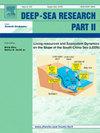2019 年夏季皇帝海山(北纬 34°-44°,东经 170°-171°)浮游动物的纬度变化
IF 2.3
3区 地球科学
Q2 OCEANOGRAPHY
Deep-sea Research Part Ii-topical Studies in Oceanography
Pub Date : 2024-10-18
DOI:10.1016/j.dsr2.2024.105432
引用次数: 0
摘要
分析了帝王海山(国角海山、神宫海山、仁德海山和须伊科海山)浮游动物的水平和垂直分布情况。浮游动物包括 4 属片足类、7 属翼足类、39 属桡足类以及底栖无脊椎动物和鱼类的幼虫。浮游动物的丰度和生物量沿 Koko < Jingu < Nintoku < Suiko guyots 系列向高纬度方向增加。Koko 和 Jingu 盖奥茨的多样性指数最高;Jingu 和 Nintoku 盖奥茨的物种丰富度最高。小型桡足类、阑尾类、糠虾类、裙带菜类、鱼卵和幼虫集中在上深海;大型桡足类和梭形纲动物集中在中深海。我们确定了三种浮游动物群落:北纬 34°-35° 之间的亚热带群落,以热带/亚热带形式为特征;北纬 38°-41° 之间的过渡群落,以亚热带、亚北极和广布物种为特征;北纬 43°-44° 之间的亚北极群落,以亚北极和广布物种为特征。浮游动物的空间分布受环境变量的影响,如表层盐度和 200 米处的温度,并在一定程度上受表层 Chl-a 浓度的影响。本文章由计算机程序翻译,如有差异,请以英文原文为准。
Latitudinal variation in zooplankton over the Emperor Seamounts (34°–44° N, 170°–171° E) during the summer of 2019
The horizontal and vertical distributions of zooplankton over the Emperor Seamounts (Koko, Jingu, Nintoku, and Suiko guyots) were analyzed. The zooplankton was represented by four genera of amphipods, seven genera of pteropods, 39 genera of copepods, and larvae of benthic invertebrates and fish. The abundance and biomass of zooplankton increased towards higher latitudes along the series Koko < Jingu < Nintoku < Suiko guyots. The highest index of diversity was recorded over the Koko and Jingu guyots; the highest species richness occurred over the Jingu and Nintoku guyots. Small-sized copepods, appendicularians, chaetognaths, euphausiids, and fish eggs and larvae concentrated in the epipelagic; large copepods and ostracods were concentrated in the mesopelagic. We identified three types of zooplankton assemblages: a Subtropical assemblage between 34°–35°N characterized by tropical/subtropical forms; a Transition assemblage characterized by subtropical, subarctic, and widespread species between 38°–41°N; and a Subarctic assemblage characterized by subarctic and widespread species between 43°–44°N. The spatial distribution of zooplankton was a function of environmental variables such as surface salinity, temperature at 200 m, and, to a certain extent, by surface Chl-a concentrations.
求助全文
通过发布文献求助,成功后即可免费获取论文全文。
去求助
来源期刊
CiteScore
6.40
自引率
16.70%
发文量
115
审稿时长
3 months
期刊介绍:
Deep-Sea Research Part II: Topical Studies in Oceanography publishes topical issues from the many international and interdisciplinary projects which are undertaken in oceanography. Besides these special issues from projects, the journal publishes collections of papers presented at conferences. The special issues regularly have electronic annexes of non-text material (numerical data, images, images, video, etc.) which are published with the special issues in ScienceDirect. Deep-Sea Research Part II was split off as a separate journal devoted to topical issues in 1993. Its companion journal Deep-Sea Research Part I: Oceanographic Research Papers, publishes the regular research papers in this area.

 求助内容:
求助内容: 应助结果提醒方式:
应助结果提醒方式:


